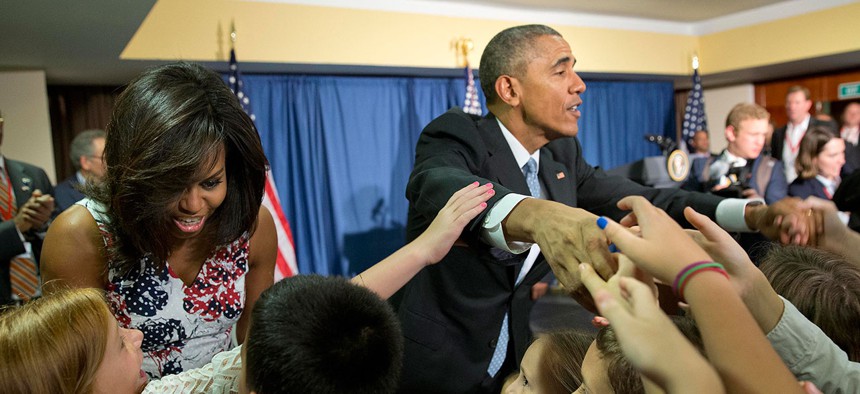
Barack Obama and Michelle Obama greet children and families of U.S. embassy personnel during an event at the Melia Habana Hotel in Havana. Pablo Martinez Monsivais/AP
What to Watch During Obama's Historic Visit to Cuba
The president traveled to Havana on Sunday for a historic three-day visit.
The last time an American president went to Cuba, he took a battleship to get there.
President Obama became the first sitting U.S. president to visit the country in almost 90 years when Air Force One touched down in Havana Sunday afternoon. The visit comes 15 months after a historic announcement by Obama and Cuban President Raul Castro that the two Cold War-era adversaries would normalize relations after half a century, a decision reached after months of secret conversations between diplomats on both sides.
Obama, who is joined by first lady Michelle and daughters Sasha and Malia, has a full schedule for the three-day trip. The first family will take a walking tour of Old Havana Sunday. The president will meet with Castro and attend a state dinner Monday, and give a speech directed at the Cuban people from the Alicia Alonso Grand Theater Tuesday.
Former U.S. President Calvin Coolidge delivered remarks at the same theater in 1928, after arriving in Cuba on the USS Texas. Back then, the U.S. controlled Cuba’s politics and economy. In 1959, Fidel Castro and his communist rebels took power, and two years later Dwight Eisenhower closed the American embassy in Havana and cut diplomatic ties between the two nations.
The embassy reopened last August, the first of a series of steps the Obama administration has taken to reopen Cuba to the U.S. Some of the biggest policy changes were announced in the weeks before his visit to Havana. The administration said it would resume commercial air travel between American and Cuban cities; lifted a ban on Cuban access to the international banking system, which would allow U.S. banks to process Cuban transactions in the U.S. financial system; restored direct mail service between the two countries; and eased restrictions on U.S. travel to Cuba. While tourism is still technically prohibited, the administration now allows “people-to-people educational travel,” which, as the Associated Press put it, “is so broad it can include virtually any activity that isn't lying on a beach drinking mojitos.”
Obama will meet with Cuban entrepreneurs Monday, and attend a baseball game between the Tampa Bay Rays and the Cuban National Team Tuesday. The administration has also allowed Cuban citizens to begin earning salaries in the U.S. without first starting the immigration process, a change that would allow Cuban athletes to play Major League Baseball and other professional sports in the U.S.
Obama’s visit is being billed as a gesture of good will and an attempt to further cement the two countries’ new relationship before the Oval Office receives its next occupant. But distrust and disagreements persist between the ideologically different governments. Obama will meet with Cuban political dissidents Tuesday, and is expected to raise concerns to Castro about his government’s human-rights record, which Human Rights Watch says “continues to repress dissent and discourage public criticism.” Obama will not meet with Fidel Castro, the 89-year-old brother of Raul whose revolution tore the ties between the U.S. and Cuba. The 1960s-era trade embargo on Cuba remains in place, and requires approval from Congress to lift it.
Still, Obama’s decision to reestablish ties bucked over five decades of bipartisan consensus, as The Atlantic’s Jeffrey Goldberg recently explained in his wide-ranging story on the president’s foreign-policy playbook. Obama “can see shades of gray in history,” Ben Rhodes, Obama’s deputy national-security adviser, toldGoldberg. “We had used the black-and-white version of history to justify Cuba policy that didn’t make much sense; that was far past its expiration date,” Rhodes said.
Recent surveys of Cuban Americans show the majority support the administration’s efforts to normalize relations between the two countries—even in Florida, where the Cuban American community, particularly an older generation that remembers well the 1960s revolution, has lobbied for decades to keep the embargo intact. Younger Cuban Americans, linked to their home country by familial ties and considerably less history, are more likely to support the policy shift, pointing to the economic opportunities that may come with it.
Surveys of Cuban citizens suggest an overwhelming majority believe a better relationship with the U.S. would benefit Cuba. For many, a visit by a U.S. president was the stuff of science fiction, says Raul Moas, who runs an organization for youth empowerment in Cuba called Roots of Hope. Moas’s parents and grandparents fled Cuba and settled in Miami in the 1960s, and some of his relatives still feel uncomfortable talking about it.
“I think Cubans would find it more believable that a martian landed on the capitol steps in Havana than see the president of the United States getting there,”Moas told me, on his way to Cuba for the visit.







